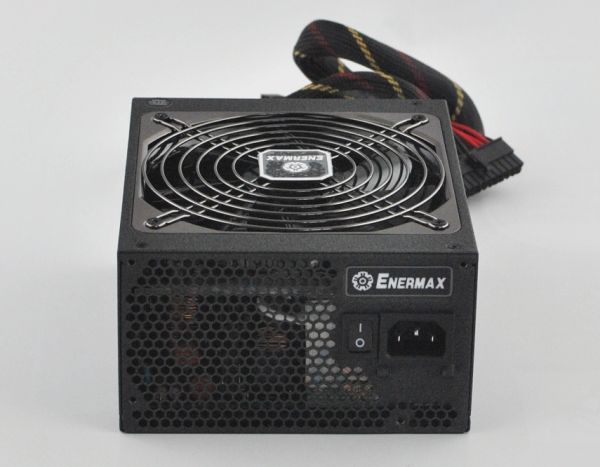Enermax Platimax 750W - 80 Plus Platinum Arrives
by Martin Kaffei on February 10, 2012 6:00 PM EST- Posted in
- Cases/Cooling/PSUs
- PSUs
- 80Plus
- 750W
- Enermax
- 80Plus Platinum
Introducing the Enermax Platimax 750W
Since the introduction of the 80 Plus certifications, we've seen a slow but steady trickle down effect where labels that were once reserved for the highest of the high-end (e.g. 80 Plus Gold) have eventually reached mainstream price points. Manufacturers including FSP, Rosewill, Sparkle, and SuperFlower now sell affordable 80 Plus Gold power supplies for less than $100. But if mainstream users are now able to get 80 Plus Gold, what should the high-end market offer? Enter 80 Plus Platinum:
Those looking for maximum efficiency can now set their sights on 80 Plus Platinum PSUs, which will be new halo market for high-end—and high cost—power supplies. To reach the necessary efficiency levels (90% at 20% load, 92% at 50% load, and 89% at 100% load), some improvements are necessary that can change some of the core characteristics of a power. Improved resonant topologies, new MOSFETs for synchronous rectifying, higher switching frequencies, better drivers, and low-resistance conduction paths are just some of the things we'll see with 80 Plus Platinum. We're naturally eager to see what the new models can bring to the table, and Enermax sent us their Platimax 750W model, which uses an optimized Modu87+ design. Read on to find out if Enermax is the new efficiency king, and how it performs in other metrics.
Let's take a first look at the near future of switching power supplies. The Platimax 750W might be relatively close to the Modu87+ series (and is definitely in the running for the worst product name award, or perhaps least creative name award), but there are some interesting new details that we will cover on the following pages. It is very important to improve efficiency without impairing electromagnetic compatibility, something faster switching might impair. So let's find out if Enermax's new components and design are enough to provide the desired high efficiency, low ripple and noise, and decent voltage regulation.












47 Comments
View All Comments
airmantharp - Friday, February 10, 2012 - link
Did you mean results?Only posted for the humor involved :).
JarredWalton - Saturday, February 11, 2012 - link
There are times when I miss our old CMS system where misspelled words were immediately underlined. Sorry for the error. ;-)Termie - Friday, February 10, 2012 - link
Did I miss it, or did you not actually list the price of the power supply in this article? I would think that would be a critical element of the review. You repeat several times that this is a very expensive power supply, but without a price stated, I don't think your readers will be able to draw any conclusions from this.I know Newegg currently has a paid add running at the top of this article showing its price for this product, but that is not the same thing as stating the price in your article.
JarredWalton - Saturday, February 11, 2012 - link
We linked to the lowest price we could find in the second to last paragraph, but you're right -- nowhere did we actually list the price. I have added that information to the same paragraph now. Thanks!DanNeely - Friday, February 10, 2012 - link
"Does anyone actually detach their CPU/mainboard cables?"2x12V cables is still a relatively high end mobo feature. Being able to get rid of one of these cables would be beneficial for many people.
Also putting jacks on the chassis for cables (GPU3, Peripheral5) only provided in high end models is rather lame in a high end model. A second plug board that leaves the two spaces unsoldered, and without cutouts in the housing shouldn't be prohibitively high as additional engineering work.
Amoro - Friday, February 10, 2012 - link
It looks like it actually failed the requirements for platinum specification at 20% load, achieving only 88.79% instead of the 90% required.Iketh - Friday, February 10, 2012 - link
I was disappointed I didn't learn what a Platinum Certification is in this article. That's the only reason I clicked the article was to get a rundown on the spec itself.Google to the rescue...
Galcobar - Friday, February 10, 2012 - link
Indeed, given the whole article is pitched as being about the arrival of a PSU able to meet the Platinum specifications, I was expecting to be told what the Platinum spec actually meant.As a result, I'm left with another question: did this PSU actually pass the Platinum specs, and at what temperature? Ecos Consulting (the company behind 80 Plus) tests at 23C, actually below the engineering standard room temperature of 25C; lower temperatures make for greater efficiency and slower fan speeds.
JarredWalton - Saturday, February 11, 2012 - link
Thanks for the comments -- I've added a bit of information to the text now.gwolfman - Monday, February 20, 2012 - link
But does this (the certification) have to apply to 120VAC/60Hz? If I remember correctly, 240VAC/50Hz is more efficient to convert to 12VDC, which will take this PSU to new heights.